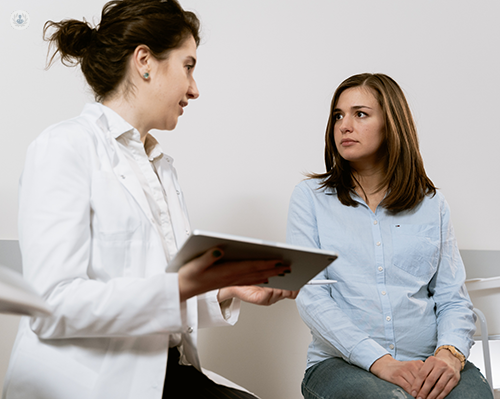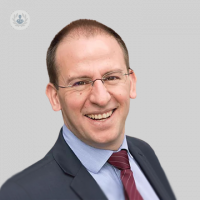Hysteroscopy: Enhancing women’s health
Written by:Hysteroscopy is a minimally invasive procedure that facilitates the diagnosis and treatment of various gynaecological conditions, enhancing both accuracy and efficacy.
Here, Mr George Goumalatsos, renowned consultant gynaecologist and obstetrician, delves into the fundamentals of hysteroscopy, exploring its applications, procedures, and benefits for women's health.

When is a hysteroscopy recommended?
A hysteroscopy is a medical procedure utilised for examining the inside of the uterus (womb).
It serves various purposes, including:
- Investigating symptoms, such as heavy periods, abnormal vaginal bleeding, postmenopausal bleeding, pelvic pain, recurrent miscarriages, or fertility problems.
- Diagnosing conditions, such as fibroids or polyps (non-cancerous growths within the uterus).
- Treating conditions and complications, such as the removal of fibroids, polyps, displaced intrauterine devices (IUDs), or intrauterine adhesions (bands of scar tissue leading to absent periods and reduced fertility).
How should I prepare for a hysteroscopy?
Before a hysteroscopy, you will undergo several tests to determine your eligibility for the procedure, including blood tests.
You will then receive a series of recommendations, including:
- Using contraception, because a hysteroscopy can’t be performed if you are pregnant or if you have engaged in unprotected sexual intercourse since your last menstrual period.
- Ceasing smoking, especially if you will undergo general anaesthesia, because quitting smoking before the procedure can reduce the risk of complications.
- If you are scheduled to undergo fibroid removal, taking medications to assist in shrinking the fibroids before the procedure.
If you are scheduled for general anaesthesia, you should refrain from eating or drinking on the actual day of the hysteroscopy for several hours beforehand. Your appointment letter will specify if this requirement applies to you.
When arriving for your appointment, it is advisable to wear loose, comfortable clothing because you will be asked to change into a hospital gown and remove garments below the waist for the procedure.
You are welcome to bring a friend or relative along for support. However, it is important to know that they won't be permitted into the operating theatre.
How is a hysteroscopy performed?
A hysteroscopy is typically performed on an outpatient basis, meaning there's no need for an overnight hospital stay. If treatment is required during the procedure or if you prefer to be under general anaesthesia during the procedure, then this will be administered.
During the hysteroscopy, you will lie on a couch with your legs supported and a sheet covering your lower body. In some cases, an instrument called a speculum may be inserted into your vagina to hold it open, although this isn't always necessary. Your vagina and cervix will then be cleansed with an antiseptic solution.
A hysteroscope (a thin tube equipped with a light and camera at the end) will be gently introduced into your womb through the vagina and cervix, avoiding the need for incisions. Fluid will then be gently infused into your womb to improve visibility of the uterine cavity. Images, captured by the camera at the end of the hysteroscope, will be displayed on a monitor for examination of any abnormalities.
In some cases, a small tissue sample from the womb lining may be obtained for further analysis, known as an endometrial biopsy. If the hysteroscopy is for treating conditions such as fibroids or polyps, fine surgical instruments will be passed through the hysteroscope to cut or remove the abnormal tissue.
The duration of a hysteroscopy can vary, lasting up to 30 minutes in total. However, if it's solely for diagnostic purposes, a hysteroscopy may take only 5 to 10 minutes.
Is a hysteroscopy painful?
The level of discomfort can differ significantly among patients. While some may experience no or minimal pain, others may experience severe pain.
If you feel uncomfortable during the procedure, don't hesitate to inform your doctor or nurse. They can stop the procedure at any point.
If you have concerns about pain during the procedure, it's recommended to discuss these with your doctor beforehand. Your doctor can provide information about what to anticipate and discuss available pain relief options.
What are the risks of a hysteroscopy?
Like any medical procedure, a hysteroscopy carries a small risk of complications, especially for patients who are undergoing treatment during the procedure.
Some of the primary risks associated with a hysteroscopy include:
- Accidental damage to the uterus
- Accidental damage to the cervix
- Excessive bleeding during or after the surgery, if you had treatment under general anaesthesia
- Womb infection
- Fainting, which may affect approximately 1 in every 200 patients undergoing hysteroscopy without anaesthesia or with only local anaesthesia
What is the recovery period like?
Your doctor will review the findings of the procedure with you before your discharge from the hospital. If you had general anaesthesia, ensure someone stays with you for at least 24 hours afterwards. You shouldn’t drive during this period either.
During your recovery, you may experience:
- Cramping resembling period pain, which typically eases within a few days. You can take regular painkillers such as paracetamol or ibuprofen to manage any pain.
- Spotting or bleeding, which can persist for a week or longer. Use sanitary towels rather than tampons until your next period to minimise the risk of infection.
While these side effects are normal, seek medical advice if they become severe. It is also recommended to consider taking a few days off from work, especially if you underwent treatment involving fibroid or polyp removal under general anaesthesia.
You can resume eating and drinking as normal straight away, starting with small, light meals if you feel nauseous after anaesthesia. You can also shower the same day of the procedure and bath the next, unless advised otherwise by your doctor. Due to potential dizziness after anaesthesia, ensure another adult is around to assist you if necessary.
As well as this, your doctor will advise you on activities to avoid during recovery, including avoiding intercourse for a week or until bleeding has ceased to reduce the risk of infection.
What is the next step after a hysteroscopy?
Your doctor or nurse will inform you of any unusual findings discovered during your hysteroscopy and discuss the outcome of any treatment administered. A follow-up appointment will then be scheduled to review the histology results and discuss any further required actions.
To schedule an appointment with Mr George Goumalatsos, head on over to his Top Doctors profile today.


